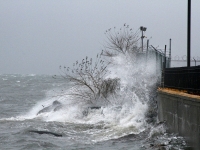Miscellaneous
Tropical Storm Rosa forms well off Mexico`s Pacific coast, no threat to land
USPA News -
Tropical Storm Rosa formed well off the Pacific coast of Mexico on Tuesday morning with maximum sustained winds near 40 miles (65 kilometers) per hour, American forecasters said, but there is no immediate threat to land. Some strengthening is possible.
As of 8 a.m. PDT (1500 GMT), the center of Rosa was located about 725 miles (1,165 kilometers) southwest of Cabo San Lucas, a city at the southern tip of the Baja California peninsula in Mexico. The tropical cyclone is moving toward the west-northwest at a speed near 7 miles (11 kilometers) per hour, leading the storm further away from land. Maximum sustained winds of Rosa are near 40 miles (65 kilometers) per hour, with higher gusts, making it a tropical storm. The storm is likely to strengthen a little through Wednesday while Rosa remains within light wind shear, but forecasters do not expect the system to become a hurricane. "Water vapor images indicate that higher shear is not far away with westerly winds located only a couple hundred miles north of the center," said Eric Blake, a hurricane specialist at the U.S. National Hurricane Center (NHC). "The cyclone should encounter these stronger winds on Thursday, which should promote weakening." Tropical Storm Rosa is the seventeenth tropical cyclone of the 2012 Eastern Pacific hurricane season, which officially began on May 15. According to figures released in late May, NOAA`s Climate Prediction Center is expecting a near-normal hurricane season in the Eastern Pacific this year. The outlook called for 12 to 18 named storms, with five to nine becoming hurricanes and two to five of them expected to become a major hurricane (category 3 or higher). An average Eastern Pacific hurricane season produces 15 to 16 named storms, with eight to nine becoming hurricanes and four becoming major hurricanes. The Eastern Pacific hurricane season runs from May 15 through November 30, with peak activity from July through September.
Liability for this article lies with the author, who also holds the copyright. Editorial content from USPA may be quoted on other websites as long as the quote comprises no more than 5% of the entire text, is marked as such and the source is named (via hyperlink).






